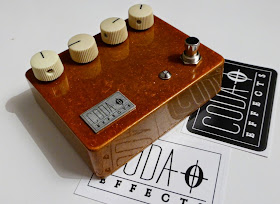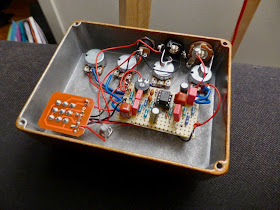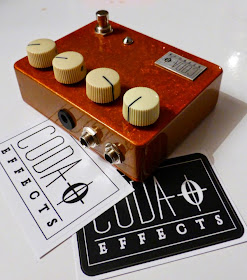I recently made a Vemuram Jan Ray clone. For the record, the Jan Ray overdrive is one of the many scandals that shook the boutique pedal community recently. Indeed, the Jan Ray has been proven to be a Paul C. Timmy slightly modified as we will see by studying the circuit. However, Vemuram pretended that it was an original design he made up listening to old Fender amps during 3 years... And sold the pedal at an indecent price for an analog pedal: 370 euros (400 dollars) ! This is a typical marketing strategy: "the price represents the quality", which is totally absurd for a basic electronic guitar pedal... He sold a lot of them whereas Paul C. produced the same pedal for 120 dollars. This a pedal that deserves to be cloned, and if you want to buy this sort of overdrive, go for the Timmy!

I made it on a veroboard, using the scheme from the excellent website Guitar FX Layouts (best website when it comes across veroboard schematics). Not much to tell you about the making, this is quite a straightforward pedal to make, even if the board is quite compact in the end ! 1uF Panasonic SMF capacitors are very space consuming, so maybe it would be better with a slightly bigger board. I started with by drilling the holes and placing the linkers (and checking connections with a multimeter), then the IC socket, resistors, capacitors, pots and jack inputs. I used a PCB for the 3PDT to make it a bit cleaner looking, as there are already a lot of wires going everywhere (4 pots is quite a lot)... My advice in those cases is to wire everything directly in the enclosure. Solder the wires to the PCB with excess length, place the PCB or veroboard in the enclosure and then cut the wire to the appropriate size, and solder them. With high gauge (like 50), you can twist the cable to make a structure to maintain the veroboard in the enclosure. It also allows you to make the cables follow the same route, thus looking cleaner.


I used a prepainted enclosure from Banzai music (the European version of Mammoth electronics), in vintage orange sparkle. It is a little bit more expensive than raw aluminium boxes, but it is really cleaner. I used the same knobs as in the Jan Ray (vintage fender, yeah !), and used a laser engraved logo. Simple and classy look I find !

How does it sound?
The conception "work" done to create this pedal can be criticized a lot, but I have to recognize that it sounds very very good. Nice saturation that goes from something light like a klon, goes through blues / rock like AC/DC, to finish with a nice overdrive / distortion. Always very nice sounding, not compressed and mushy, with a possible huuuuuge volume intake. The volume equivalent to the bypass volume is at one quarter of the knob value ! Great for soloing or to play with a volume pedal placed after it. Equalization is reactive and allows you to add or withdraw bass and treble efficiently. It is a very transparent overdrive that respects the guitar and amplifier that you use. I recorded some samples (camera mic, sorry...) with my Les Paul 54 reissue (P90 goddess), my vox lil' night train and a malekko Spring Chicken to have a bit of reverb. In the end of the track, I used my boss DD2 for a 80s saturated type of sound (yeaaahh !)How does it work?
Here is the schematic of the Jan Ray circuit as it is on the veroboard (a bit different from what you can find online, but functional !)
Vemuram Jan Ray schematic (Made with Eagle)
It is quite a classical layout, using the 2 OP-amps included in the LM4558 IC. The first OP-Amp is used to clip the signal to generate saturation, whereas the second one is used as a basic volume boost. Let's divide the circuit in different sections.
The first "input" section has different roles. First, there is a 47 uF coupling capacitor to eliminate any DC current that could go in the circuit. There is also a 1M pulldown resistor used to avoid popping noises when the effect is turned on. These noises are due to a small charge that accumulate at the entry of the circuit and cannot go through the first coupling capacitor. When the effect is turned on, this charge goes through the circuit and causes the awfully loud "pops"... To avoid this, a 1M resistor is linked to the mass to absorb the excess of current.
The signal then enters the gain/dirt section, which role is (obviously) to generate saturation. It enters in the first OP-amp of the LM4558 (it is a double OP amp), which has an inverted feedback loop to amplify the signal. The signal goes in the loop. High frequencies can go through quite easily with de 47 pF capacitor. The remaining signal will change depending on many parameters :
- the gain potentiometer acts as a variable resistor connected that will reduce more or less the current going through the loop. The amplitude of the voltage going through the diodes will varies, and thus will be more or less clipped.
- A trim potentiometer combined with the 9.1k and 600 ohms resistors allows you to tweak the maximum possible gain. This is useful to adapt the maximal gain setting depending on the output levels of your pickups.

Fig. Diode clipping system in an amplification feedback loop
Using two diodes following each other like in the Jan ray makes the clipping less important, and thus "uncompresses" the sound. Your playing and pick sensitivity is still audible because the signal is not as clipped as in other saturations like a big muff. A very simple mod to ear that is to use a switch to choose between 2 or 4 diodes in the loop. The Timmy by Paul C has this option for instance. Then, the signal goes through the output/volume section. A potentiometer is wired as a variable resistor to act as a low pass filter to adjust trebles. The signal then goes through the second OP amp that is just used to amplify the signal. The 3.3k resistor determines the gain of the amplifier, which is set quite high.
Finally, a coupling capacitor filtrates DC current that could have gone through the loop and thus only allows the signal to go through. Then, a potentiometer wired as a variable resistor to the mass allows you to diminish the amplitude of the final signal, constituting a classical volume knob. This almost the same volume control than in the fuzz face !
Last section of the pedal: stabilization of the power supply and "creation" of the VREF ("power supply section"). The diode at the entry protects the circuit from polarity inversion. Two grounded capacitors are there to get rid of the ripples that might be present in the power supply. Low frequencies are eliminated with the large 47uF capacitor, whereas the 100 nF capacitor is used for high frequencies. In the end, we have a proper +9V voltage that can be used with the OP amp. Another part of the current is used to create the reference voltage (VREF) by going through a 9,1k resistor.
Did you like this article? Thank me by liking the Coda Effects facebook page or subscribe to the mailing list!
Any question? Post a comment!
To go further:
Pulldown resistors: http://www.muzique.com/news/pulldown-resistors/
Tube Screamer circuit analysis (circuit is closed to the timmy / Jan Ray) : http://www.electrosmash.com/tube-screamer-analysis#power



This comment has been removed by the author.
ReplyDeleteHi, thanks for sharing your knowledge!
ReplyDeleteHow can I mod it to play it with a bass? I mean to free all the low frequencies and not having any low end cut.
Thanks for your help! Cheers
Yes I think so! The best way would be to increase capacitor values; for instance replace C1 by a 1uF cap. Reading again this blog post, I think I need to remake the schematic on a more understandable way
DeleteCan you tell me Jan Ray is by thought of ocd second clone, clone of Timmy, who is the first clone?
ReplyDeleteHi, great article, it motivated me to build one. I like the sound but in mine I have the feeling there is a lack of upper mids. Is this the character of the design? Is there a way to substitute a part to accentuate the upper mids more? Thanks!
ReplyDeleteCan you share the eagle file? Thank you. :)
ReplyDeleteHi, one question.. what value do I have to use for the voltage divider?? 9V to a 9k1 resistor and 7k5 resistor to ground?
ReplyDeleteHi! My father is going to build this pedal for me and he´s asking about the bypass footswitch. He says that part is not included in the schematic. How did you build the true byass footswitch? (I guess is the little orange board that is shown in the picture, right?)
ReplyDelete(Sorry for my english!)
Hey man, is there any chance you could post the bill of materials? It would be nice if i could just look them up on mouser so i can purchase everything and print my own pcb based on your schematic
ReplyDeletecan you share the eagle file?
ReplyDeleteI am so happy to read this. This is the type of manual that needs to be given and not the accidental misinformation that’s at the other blogs. Appreciate your sharing this greatest doc. https://royalcbd.com/product/cbd-capsules-25mg/
ReplyDelete